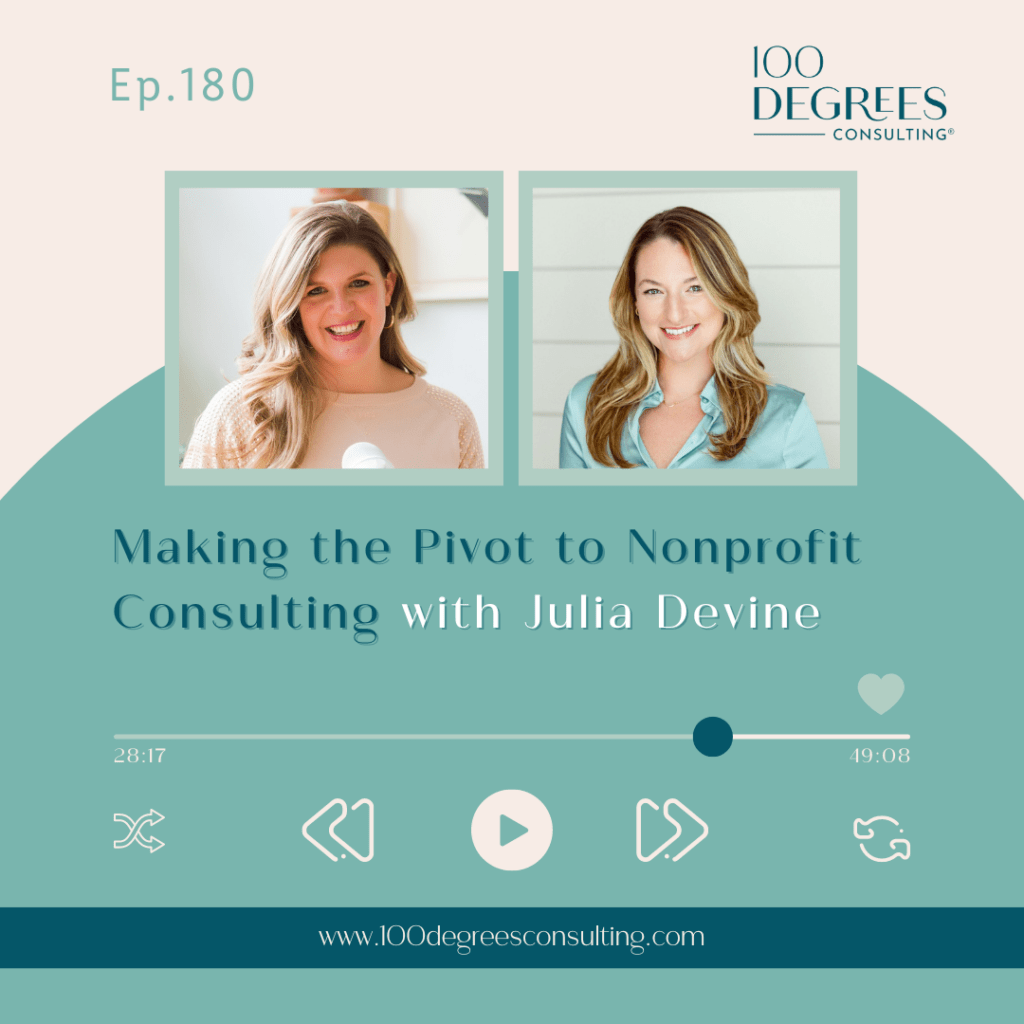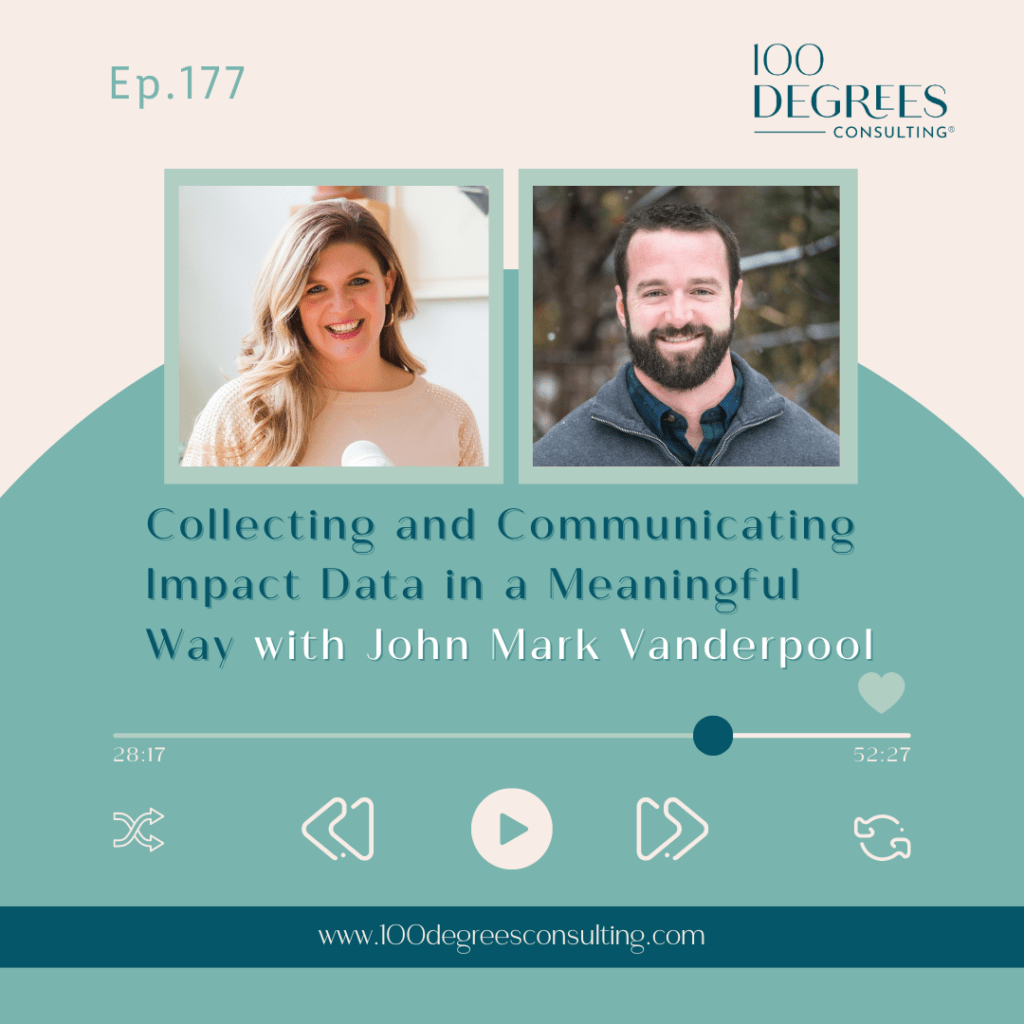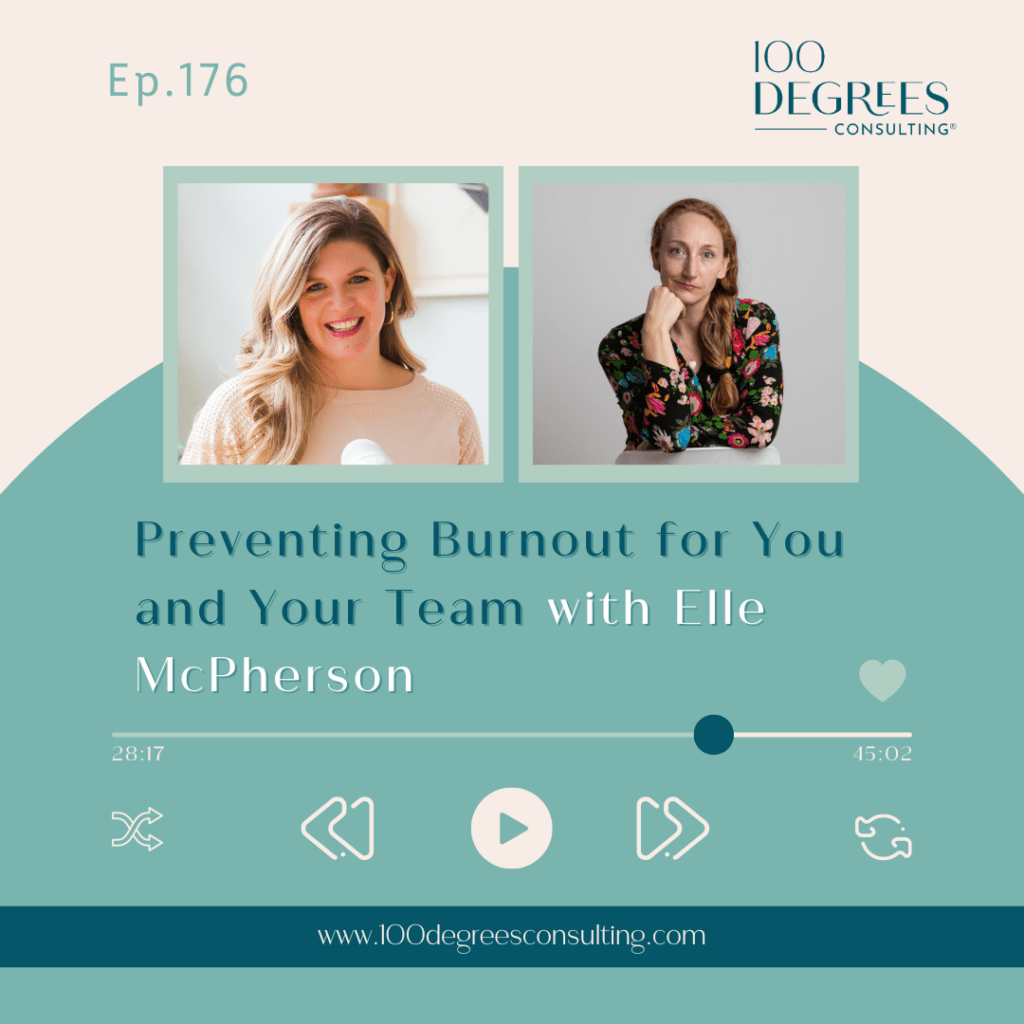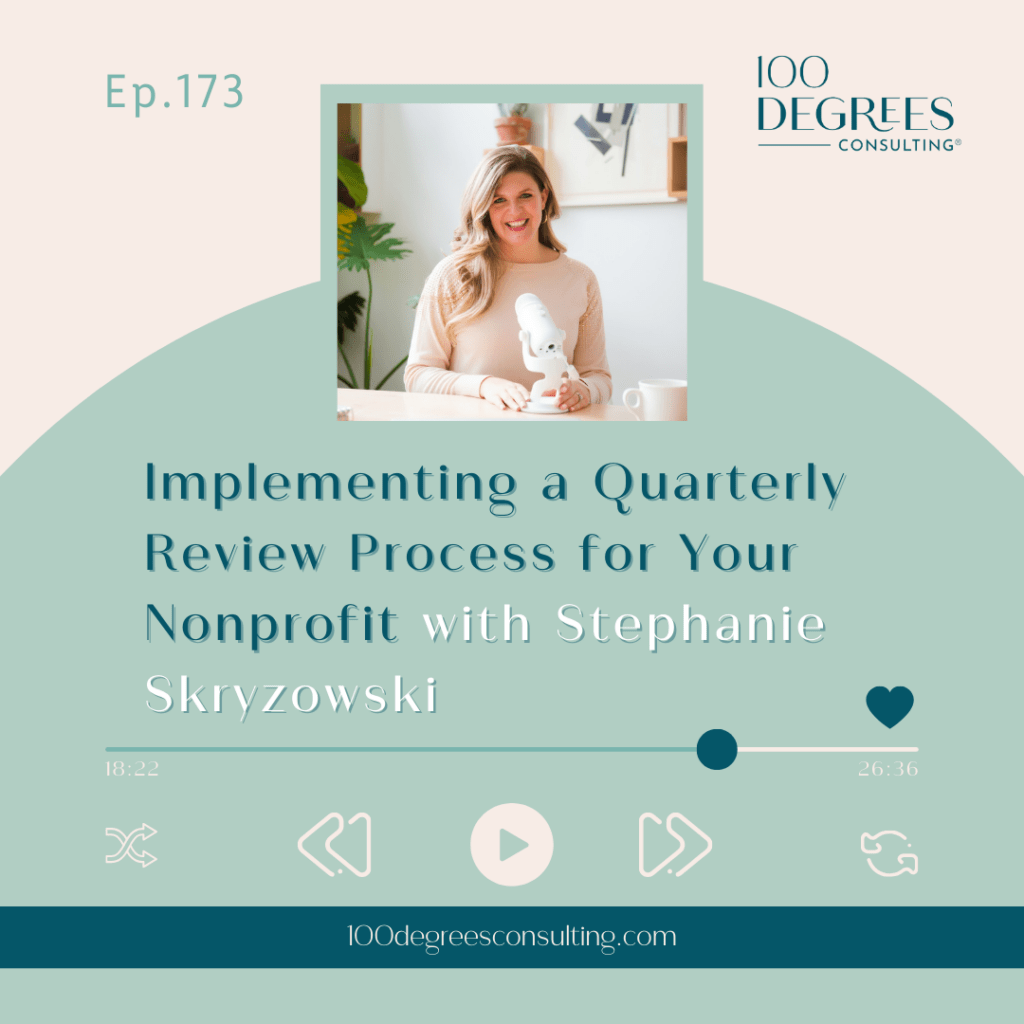Transcript Episode 179 – Using Cross-Sector Collaboration to Maximize Your Impact with Jennifer Hutchins on The Prosperous Nonprofit
[00:00:00] Stephanie Skryzowski: Welcome to the Prosperous Nonprofit, the podcast for leaders who are building financially sustainable and impactful nonprofits and changing the world. I’m Stephanie Skrzewski, a chief financial officer and founder and CEO of 100 Degrees Consulting. My personal mission is to empower leaders to better understand their numbers, to grow their impact and their income.On this show, we talk to people who are leading the nonprofit sector in new ways. Innovative, disruptive, and entrepreneurial ways, creating organizations that fuel their lives, their hearts, and their communities. Let’s dive in.
Hello. Hello. Welcome back to The Prosperous Nonprofit. I’m Stephanie Skrzewski. And today I have with me the executive director. of the Maine Association of Nonprofits, Jennifer Hutchins. Since 2016, Jennifer has been [00:01:00] the ED of the Maine Association of Nonprofits, the state’s leading organization for Maine’s charitable nonprofit sector, with over a thousand members from all 16 counties.
She’s on the board of the National Council of Nonprofits and the Maine Philanthropy Center, as well as on the advisory boards of several other organizations. Prior to joining MAMP, she was executive director of Creative Portland, where she led the city of Portland’s efforts to strengthen the creative economy.
She has a rich history in the nonprofit sector, and what I think she brings to the conversation today is a really unique perspective on nonprofits, because as the ED of an organization with over a thousand members, all of which are nonprofits, she gets to sort of get a, a pretty big cross section of the nonprofit sector in her work.
And so today on the show, we are talking a lot about the importance of cross sector collaboration. And she gives some really good examples on how [00:02:00] nonprofits collaborating with a federal government, the state government, corporations. other nonprofits in their communities have been able to make a massive impact and a lasting impact more than they could have made on just their own.
And we talk about some of the barriers to collaboration and why all nonprofits are not doing this. And there’s very real barriers and we talk about that quite a bit. And so she gives us some fantastic examples of collaboration. We talked a lot about why. What she sees in terms of trends and challenges and opportunities facing the nonprofit sector today.
And again, I just, I love her perspective because she does have such a nice cross section of our sector, basically the entire state of Maine. So one 50th of the U S nonprofit sector, she’s got a really great perspective on and we get to hear that today. So without further ado, let’s go talk to Jennifer.
Hey, [00:03:00] everybody. Welcome back to the Prosperous Nonprofit. I’m really excited to have here with me today, Jennifer Hutchins of the Maine Association of
[00:03:08] Jennifer Hutchins: Nonprofits. Jennifer, welcome. Oh, thank you, Stephanie. I’m really excited to be here with you. You do a great job. [00:03:13] Stephanie Skryzowski: Thank you. Thank you so much. And you know, we have been partnering together, your organization, I’ve done some education for your members, and it’s been just such a joy working with some of the nonprofits in Maine, as well as your team.And so I’m excited to dig a little bit deeper into Your work today. So I would love if you could just start us off by, by telling us a little bit about your own journey. What has that looked like and how, how did you get to where you started to working, um, at the Maine Association of nonprofits?
[00:03:44] Jennifer Hutchins: Well, thank you, Stephanie.I really love this question and I, you know, it’s so self centered that I feel kind of honored to have this space to tell the story, but I think it’s really helpful because ultimately, um, I’ve always been driven by mission. [00:04:00] and my purpose in life and early on in college I discovered that at the end of the day what I was interested in doing was supporting my community and doing what I could do to solve the problems that my community faced.
And I knew that right out of college. But it took me a little while to recognize that for me, based on my skill set and my personal passion, that the non profit sector was where I could have the most impact. And, um, I had majored in political science and so back when I was in school in the 80s, you know, there wasn’t as much of a professional focus on the non profit sector.
It was Much more. You either got your MBA or you got your master’s of public administration and you had to kind of choose from these two big sectors. And so it took me a little while. And then I landed in Washington, DC working for a nonprofit organization. That was my first exposure. And then, um, and then [00:05:00] I found out in Washington, DC that they were, that there, Well, let’s just leave it.
The Washington, D. C. is a very complicated place, and I, um, made some different life choices that made me realize that in a state like Maine, where we only have 1. 3 million people in the entire state, that I could have more direct impact on my community just because we had smaller scale. And, um, I ended up getting my master’s here and it really was about, um, realizing that we as a community, as local communities, we didn’t have to focus on these big institutional agencies.
We could really think about Individual people coming together, identifying an issue, an opportunity or a challenge in their community and saying, Okay, what do you have? What do you have? What do you have? How can we take advantage of or solve this issue? And I really realized that it [00:06:00] was a cross sector solution.
It required people coming together around the table as partners and tackling the things in their community. I basically decided, uh, that I wanted to be in a position where I could do that in Maine, and the Maine Association of Nonprofits has really enabled me to do just that, is to focus on the, the hundreds and hundreds of nonprofits that are here in Maine, that are people coming together to benefit their communities, and then at MIMP, We’re really trying to focus on how can we empower those organizations and those people in those communities to work with bigger institutions in government and business to really make a difference and to, as you well know, address the myriad of really incredible missions across the sector.
[00:06:57] Stephanie Skryzowski: I, I love that. Thank you so much for, [00:07:00] for sharing all of that. And, you know, I’ve worked in organizations before that, that feel very like insular. And there’s not a lot of collaboration going on either with other nonprofits or even just with other organizations. organizations, businesses in general, except for, of course, the like, we’re going to ask people for money.But beyond that, like there was not a whole lot of collaboration going on. And I love how, you know, as executive director at MAM, you’re able to really help move the needle on that. So I would love to hear a little bit more. Can we talk a little bit more about cross sector collaboration? Like what are nonprofits in Maine doing to collaborate with other organizations sort of outside their little bubble?
And what is the impact of that?
[00:07:45] Jennifer Hutchins: Yeah, definitely. One thing I want to start with, Stephanie, is one thing that we’re trying to elevate also with the Maine Association of Nonprofits is the idea of the funder community [00:08:00] recognizing, certainly, the value of nonprofits collaborating But also the unique challenges that nonprofits face in knowing how to collaborate.There’s a strong message that comes from those in the funding community, whether they’re individual donors or they’re private foundations or it’s government agencies or it’s corporate sponsors about. Why are there so many nonprofits? Why don’t you all get together and figure out how to collaborate?
Right? And there’s so there’s a strong message about the need to collaborate. What I believe and what the Maine Association of Nonprofits also points out is that it’s also beholden on the funder to understand what are the barriers to collaboration for the nonprofits. It’s not simply an executive director doesn’t want to talk to their neighbor.
Right? Like, it’s not that an executive director or a board of an individual organization is saying, no, we’re the only ones who care about the fish in the stream and we’re not going to talk to anybody else. [00:09:00] It’s not that, you know, board members are our neighbors and our friends and the people who run these organizations.
And so I really feel like it’s important for the funding community, no matter where that source is coming from, recognizes that there are very specific systemic barriers. system built barriers to not helping nonprofits collaborate. And that is, there is the paradox in the nonprofit sector where nonprofits are asked to both compete by competing for grant funding or competing for individual donors and, you know, act like a business, right?
Like make sure you’re applying all of your marketing in a way that a business would. And so. All of these, and some of this is great. I’m not saying it’s wrong, but to recognize the paradox for nonprofits where they’re oftentimes being asked to operate like a private business, but then act like this [00:10:00] social feel good, everybody collaborates and get along.
And so there’s always this tension when you’re running a nonprofit of like, okay, so I’m supposed to, Collaborate with my friends, but I was supposed to compete with them for funding. Okay, how do you do that? Collaboration takes time. And it also takes skills. That, Oftentimes, nonprofit leaders don’t have sophisticated collaboration skills.
It’s not easy to figure out how to manage a collaborative partnership. And the non, nonprofit sector, the way we have it set up is that. We’ve also been asked to invest all of our money directly into the mission, right? Like, okay, what funders say, okay, we’re going to donate to you this funding, but we want it to go directly to the fish in the stream.
We don’t want to find out that you’re buying yourself like cushy chairs or [00:11:00] a sophisticated technology system, or develop your staff through professional development and teach them how to do collaboration well. No, no, no, don’t spend your money on that. Make sure it goes only to the fish. But what we know about impactful collaboration is it takes people who have skills and then the time, the space to be able to develop a really sophisticated partnership.
But if we’re also expecting non profits to just make sure all of their funding goes directly to the end user and not invested in staff or skills or the time to explore, then it makes collaboration even that much harder. So, uh, So you were asking about cross sector collaboration. I think where it’s successful is there are pockets of the funding community and coming together with foundation and foundation community coming together with individual non profits where the foundations are coming together.[00:12:00]
funding the space to develop collaboration skills and to create the time and space that they need to explore these collaborations. And that recognition is popping up in different places where funders are coming together and recognizing that. And then I think once you see that, Once you see individual nonprofits being supported in the true benefits and potential impact of collaboration, I think that’s where you’re seeing some, some good success.
[00:12:36] Stephanie Skryzowski: That is, yeah, that’s such a good point that, you know, we have these really high expectations of our nonprofits, but they get zero resources to execute on those expectations. So that totally makes sense. And I was going to ask you, and you sort of mentioned it, but I wonder if you’ve got more. I was going to ask for, um, some examples of, of, uh, Good collaborations that you have seen in the sector and I [00:13:00] love your example of the foundations bringing organizations together and actually funding that, you know, skill building capacity building, um, experimentation space like that’s huge.I am not seeing that happen a lot. Um, I, I love that it’s happening at least on a very small scale, but are there any other examples that you’ve seen with organizations in Maine or elsewhere, really a really solid collaboration?
[00:13:27] Jennifer Hutchins: Yeah, for sure. Uh, we held an event, um, a few months ago that was about cross sector collaboration and, um, our foundation, one of the people on the panel was the, the head of the Sewell Foundation, which is a main private foundation.And she talks a lot about, I thought I should just mention, um, the trustbasedphilanthropy. org, which is a group of, of foundations that are recognizing the inherent power imbalance between [00:14:00] foundations and nonprofits. And, um, People are interested in this concept. I would encourage people to look at trust-based philanthropy.org.
There’s also community-centric fundraising.org, which is a fundraising model that’s grounded in equity and social justice. And um, in that case, they are looking at the entire community over individual organizations. So I wanted to have a chance just to mention those. to groups because they’re doing some really great cross sector work where you’re putting the community issue at the center and then you’re bringing the organizations and the people to the table that are needed to solve that issue rather than focusing on individual organization missions.
So there’s some examples there. But then to your specific question, so when we had this event a few months ago, we also had, um, a representative from one of the large health agencies here in the state. And she talked about the collaborate, huge [00:15:00] collaboration that happened around COVID and vaccinations and the vaccination situation required really fast partnerships between nonprofits and government in particular.
And she really feels that. Well, and then Maine ended up having the fastest and most comprehensive vaccination rate in the country. And she really said that that relationship that the non profit health system in Maine, which is, um, in other states, uh, the, there is the more sophisticated public health system that’s run by the government.
In Maine, it’s much more run by a 501c3 nonprofits. And so it required a relief. Fast, rapid communication system among the different health agencies in partnership with government. And in that particular case, it really, and she really attested it to the nonprofits having more flexibility than the government [00:16:00] did to be able to immediately reach the end user.
And so she was really highlighting how it was such a great partnership because government had access to financial resources, and they had direct lines to supply of vaccinations through the federal government. But then they needed a system by which they could quickly distribute to as many people as possible.
And the non profit sectors really set up to access, uh, You know, small pockets in the state, um, because not just the big hospitals, but then we have all these little health, um, because Maine is made up of a lot of very small towns and communities. Then we have these little pockets of small health centers and the hospitals were able to use their networks and their, their partnerships.
And then we had communities of disenfranchised people who didn’t necessarily have a, a, a, a, a, a. [00:17:00] a bricks and mortar community center, but again, it was the nonprofits that had their finger on the pulse, literally, of people in the community who are disenfranchised, who potentially didn’t have a home or didn’t have a standard, um, community institution to rely on.
But it was those small nonprofits that are doing outreach to those people and they were able to build a network and Maine had this incredible rate of vaccination compared to the rest of the nation. It was a incredible story.
[00:17:31] Stephanie Skryzowski: Yeah, that is huge. That is so powerful. And I think that’s a perfect example of this cross sector collaboration to actually, uh, move the needle.So, fantastic. Thank you so much for I have one other if you like. It’s Please, yes, give us all the examples. I love it because I think this really helps our listeners be like, Oh, I hadn’t thought of that as an opportunity or as potential. And so, yes, we love examples. Give us another.
[00:17:58] Jennifer Hutchins: Well, this is another, [00:18:00] unfortunately, this is also an emergency type situation.So, um, I want to acknowledge that unfortunately it’s a situation that. Too many communities in our country are facing these days, but this is in response to when one of the towns in Maine experienced a mass casualty violence, um, through a shooter that, um, came into private businesses. And so it’s built on a tragedy, unfortunately, but the resulting, what I want to think about, focus on is the resiliency and the partnership that formed among government business and nonprofits in the aftermath of that tragedy.
And it’s one of those things where you almost, you will, a case study, what could be so illuminating and to your listeners, I do think it’s really important to recognize because sometimes a case study You know, goodness knows we never want this to happen to any community in the future, but it does highlight [00:19:00] how literally what happened was one of the nonprofits in the Lewiston region said, okay, after that sudden, sudden occurrence, what is our role and what can we do about it?
And it was literally one executive director talking to one program officer in the local organization, sitting there saying, Who do we call? We don’t even know who to call. And so very quickly they had to expand on their, just their professional networks and start calling around to their emphasis, the relationships, their existing relationships with government leaders and business leaders to say, okay, who do we turn to?
What do we do? And it turns out the federal government has a system of resilience hubs that are funded through the state department for communities that have experienced violence, mass casualty violence, like the city of Lewiston did here in Maine, unfortunately. So the federal government had [00:20:00] resources to bear.
This non profit stood up to say, okay, we’ll be the organizational container for that. The state brought in their emergency management folk to come in and help coordinate. And then the non profit who already had relationships with, with businesses through sponsors and through funders, then turned to their corporate sponsors and funders and were able to find an empty office space that had just been vacated by a local main company.
So it had some furniture. It already was a comfortable space and they, in just a matter of weeks, came up with this resilience hub, which is meant for the people directly impacted by that violence, and they’re still running today and they provide mental health services and they provide just a community place where people, families can come and just sort of get out [00:21:00] and share.
their experiences through that. So again, I just want to highlight that it’s, I want to tell people the story about It really isn’t simple as an executive director in an existing non profit saying questioning what is our role and who can we turn to and they relied on some existing relationships and started asking questions and relied on their own knowledge of the community and started bringing the right people to the table and providing such an incredible resource for that community.
[00:21:38] Stephanie Skryzowski: I especially love, um, I mean, I love everything about that story except for the fact, like you said, that it spun from, you know, a horrible tragedy, but I love the fact that at the end you were saying that this resource for the community continues to live on. So it wasn’t just like a flash in the pan sort of one time project that ended.It was like, [00:22:00] out of this horrible tragedy. And then the subsequent collaboration came this ongoing resource for the community. And I think that’s, um, that’s incredible. Yeah. Thank you so much for, for sharing both of those.
Are you tired of navigating the labyrinth of software options? Wondering what works best together and how to afford it all? It is a dizzying task from choosing the right accounting software to ensuring seamless integration between all the systems. Feeling lost in the jargon, fear not. Introducing the best tools for an efficient and prosperous nonprofit.
This free resource is a curated collection of top notch software solutions personally endorsed by our team at 100 Degrees Consulting. Visit 100degreesconsulting. com slash tools to access our handpicked list designed to streamline your operations and boost your nonprofit success without. Adding a [00:23:00] ton of extra cost or extra team.
Don’t miss out. Head to 100degreesconsulting. com slash tools now to download the best tools for an efficient and prosperous nonprofit. Let’s elevate your nonprofit to new heights.
I want to switch gears just a little bit because I want to tap into the interesting perspective that you have in seeing a lot of nonprofit organizations. So being the executive director of a state association of nonprofits, you’re not, you know, you are working for a nonprofit, but you also have the perspective of, you know, how many members do you have actually?
We have about 1, 100 across the state. That’s what I thought. I was going to say over a thousand and then I wanted to make sure I got the number right. Um, yeah, so 1, 100 nonprofit organizations and you’ve worked in the sector for a long time. So what trends are you seeing in the nonprofit sector right now, at least across the [00:24:00] organizations in Maine, are you seeing things shift where now, you know, four years, I mean, sort of four years post COVID, four years post the beginning of COVID, I should say.
It is sort of like this new time. I’m seeing things shift from the organizations that we work with, but, but what trends are, are you seeing happening? And it could be related to literally anything.
[00:24:21] Jennifer Hutchins: Sure. Yeah, absolutely. Two years ago, at the end of 2022, we, instead of doing a kind of a traditional annual report, we decided we wanted to put out a document that we called the Impact Snapshot.And it was really, um, what it was our best way of summarizing some of the key themes that were emerging outta, um, 20 20, 20, 21, 22. And the five themes that we highlighted back then were. One. impacting change and a, a, an interest in getting more [00:25:00] engaged in advocacy for the sector, particularly with the public sector, that, um, more organizations, I think in some cases, because of the nature of the pandemic, in many cases, I think nonprofits saw their relationship to the federal government more than ever, right?
Whether it was through the PPP program or the earned revenue tax credit program that came out, so many small nonprofits, which make up the vast majority of nonprofits in Maine, benefited from those programs. And so there was this. this awakening of, oh, I see, we are directly connected to the system that supports the work we do.
And so advocacy is one of those things, figuring out how we can not just work with government policy, but advocacy around social change and making a difference. And, [00:26:00] um, even though we do tend to be in organizations or. tend, non profit organizations tend to need to focus really directly on their mission because they don’t have a lot of extra resources going around.
There does seem to be more attention towards, okay, we’re part of a bigger system and we understand how some of these things work. bigger issues impact us. And so, um, we have a whole area focused on advocacy and, and impacting change, um, for organizations. The other thing is the focus on, um, diversity, equity, and inclusion that many, many organizations were involved with.
prior to 2020, but at the same time as the pandemic, there was the George Floyd murder and other developments that came out of that. And so more focus on equity. And again, it’s a systemic issue of, Oh, wait a minute. The nonprofit sector was set up at a time when not everybody who set up the [00:27:00] rules back then were at the table.
And so this idea of what can you do within the nonprofit sector. To, um, encourage equity and making sure that people who are impacted by nonprofits are part of deciding what the solution should be. The third thing is workforce. Then the workforce has continued to be a serious issue. Of course, it’s a national issue.
There was the great resignation during the pandemic of people deciding to leave their leadership jobs. Um, and again, all of this. stuff has existed before the pandemic, but the pandemic just really opened up the flood gates in terms of the changes in the workforce. And so focusing on understanding what the nonprofit sector needs in terms of workforce, and then in a state like Maine, where we’re considered one of the oldest states in the nation, we have an even more acute.
Um, pressure towards especially direct care [00:28:00] workers and frontline workers. Um, and we have a real, real deficit of supply in, in that sector of the workforce. Um, the fourth thing was strategy. It really came down to, um, organizations seeing demand increase and funding decrease. And there’s a lot of ways to slice that.
Data when it comes to funding, some people would say that funding has increased in some areas. But what we’re also seeing is that it’s maybe more money, but it’s spread out across fewer donors. So, um, There’s some mega contributors that are putting money into the system, which is great, but that means that that money is going to a fewer number of organizations, and so the diversification of funding, and it’s making smaller.
tougher for smaller organizations to [00:29:00] break into those resources. And then the fifth thing, and so strategy, meaning organizations are coming to us more and more and saying, we need to rethink how we do things. And whether it’s collaboration, whether, you know, which could potentially lead to a merger, it doesn’t need to.
Collaboration has meant, takes on many, many different forms. Or, you know, we need to really think through how we’re Looking at our business model, how can we be more entrepreneurial? How can we save resources? All the myriad of ways that you can look at your business model. So it’s really re looking at strategy in a serious way.
And then the fifth thing is building better boards. And, um, recognizing that organizations, uh, similar to, uh, The workforce being under pressure, the volunteer community is under pressure, um, and, and to have boards that can really support these organizations and their missions is something that, uh, our organizations [00:30:00] are looking at.
[00:30:01] Stephanie Skryzowski: Mm hmm. That’s fantastic. That was very, uh, comprehensive. So I love that you have that, that, um, survey data at your fingertips. Because I would imagine then that you can help the nonprofits in Maine really understand what opportunities there are. Maybe those are some of the, you know, the trends and the challenges, but what opportunities are you seeing for organizations to thrive despite these things that are really challenging in this new post COVID world?What are you seeing organizations doing that are really thriving right now? Well, I will, um,
[00:30:39] Jennifer Hutchins: a couple of things I want to highlight. I just recently attended our national conference, the Maine association of nonprofits as part of a larger network called the national council of nonprofits. And I just returned from Washington, DC, where we talked about some of those major trends.And in terms of, uh, [00:31:00] Thriving. One of the things I want to mention is that we focused a lot on making sure that nonprofits are taking care of the people who are currently working for them and building organizations that are attractive places for people to want to work. And so first thing we talked about, we talked a lot about burnout and we learned a lot about what it means to have employees who aren’t burned out.
We know that in the nonprofit sector, particularly because it’s a mission centered, um, sector that people are already dealing with heavy issues in some cases, and so then, you know, then you add on top of it, all the other reasons why workers are, are getting increasingly burnt out post pandemic. It’s really important for thriving nonprofits who want to thrive to really pay attention to their employees and what they need, and there’s some great resources out there, but very specifically the thriving nonprofits are the ones that are [00:32:00] taking a hard look at compensation and paying attention to how they’re making sure they’re.
being competitive in the marketplace with the types of people that they want to attract to their nonprofits. And they are looking at their compensation philosophies. They’re looking at their benefits. Um, uh, some of the thriving nonprofits that I’ve talked to have a very transparent. compensation and benefit package.
And so they talked to their employees and they say, what are the benefits that mean something to you? Um, someone in their twenties may want something very different than someone in their sixties. And, um, you might be surprised about if you actually talk to your employees, what is it they value about Working in your workplace and the benefits that you offer them, you might be kind of surprised that, you know, having an extra day off is actually more important than, you know, long term care, [00:33:00] disability insurance, or I, you know, I don’t know what, what it might be.
It depends. But the, to your question, what are the driving nonprofits do, they really recognize that the workforce, the job market is extremely competitive and taking care of your employees is really, really important. The other thing that we talked about at the National Council is AI, artificial intelligence, and the importance of.
Um, something that the non profit sector would benefit really paying attention to. Um, we know that non profits are already using it, mostly from a writing perspective. They might be using it to help with starting the grant proposal and then editing it, right? Or the fundraising letter, or, you know, there are different ways that people are just starting to dip their toe into it with the non profit sector.
But it’s an emerging Field that we hear a lot about in the broader community and in [00:34:00] broader media Uh, but there is this idea of In other countries, they’re starting to use AI around that whole direct care worker gap that I already mentioned that we have here in Maine is how can AI, um, help us with our workforce deficit, our worker deficit that are providing these direct care workers.
benefits to some of the people in our community. So, um, I would highlight those two things as being really interesting areas where nonprofits are starting to think through what is it going to take to make sure my nonprofit is thriving into the future.
[00:34:39] Stephanie Skryzowski: I think that’s huge. I love that you mentioned talking to your employees about benefits because you’re right.We all do have a different opinion on what is most valuable to us. And I’ve actually done that at my company because I thought that, you know, a certain thing was, was most valuable and they were like, honestly, we would rather have this. And I’m like, Oh, [00:35:00] okay, cool. Did not know that. Great. We’re going to go this direction then.
So I think that’s huge. I was just talking to another organization last week who got a very large for them, um, unrestricted gift. And the first thing that they did was to basically right size their team. And that doesn’t necessarily mean adding more people. I think for them, it meant adding a couple. But getting their salaries to an appropriate level because they had all been so underpaid for so long.
Um, and so giving them appropriate size increases to get their salaries, to be where they need to be at the marketplace, as well as ramping up their benefits. And so now that they’ve done this. They’re like, okay, that’s taken care of. Now we can figure out, great, what else do we want to do with this money?
Um, and so I just, I love that that was their first step. Their first step was to let’s pay our people because we know that the impact that we want to have is not going to be there if our people are burning out and leaving. Like that is [00:36:00] not going to work if everybody leaves and we have to replace everyone because then we’re starting from scratch again.
So yeah, I think that that is so important. That’s a fantastic answer. One more, I’ve got like two more questions, I think, before we wrap up. So you obviously, you’re the executive director of the Maine Association of Nonprofits, and it is a, it’s a state association that’s part of the National Council of Nonprofits, um, and I would love to hear you kind of talk a little bit about the benefits for a nonprofit to join their state association, because there are state associations in almost all of the states, and I know, because I’ve worked with you, um, As well as a couple other state associations.
There are huge benefits, but, um, if somebody is listening and they’re like, Oh yeah, I lead a nonprofit. Like should, should I join our state association? Talk to us a little bit about what, what does membership look like? What does it mean? What resources are you able to provide to nonprofits through the association?
[00:36:54] Jennifer Hutchins: So as a member of the Maine Association of Nonprofits, we essentially talk about [00:37:00] what we do in three buckets. And one of them is the advocacy piece. And so we do advocate for nonprofits at the state level here in our state capital, which is in Augusta, Maine, and then through the National Council of Nonprofits, the federal level.So the National Council is really credited with Um, making sure that nonprofits were eligible, small nonprofits were eligible for the PPP program. When that program was originally set up, it said small businesses. And the National Council of Nonprofits, I recognized that and they stepped in and they said, Hey, You need to make sure that 501c3 nonprofits are part of that.
So right there, direct impact, federal level advocacy, impacting all nonprofits. Here in the state of Maine, we just passed legislation that, that, uh, we just were able to get legislation passed where the governor included in her budget, a blanket sales tax 501c3 [00:38:00] nonprofits prior to this year. Um, there were only some.
501c3 nonprofits that were exempt from paying sales tax on products and services in the community. And, um, all of the other New England states that charge sales tax had just said, if you have a 501c3 designation, you’re automatically exempt. Um, Maine did not have that. It was on a case by case basis. And so what did we do?
We focused an entire person on our state. team focusing on that for a year and a half to get that included in the governor’s budget. And as of January 1st, if a non profit in Maine has 501c3 designation, they can receive a certificate demonstrating to any vendor that they are sales tax exempt. And we were able to do research ahead of time to find out that this could mean Hundreds or thousands of dollars for not these small [00:39:00] nonprofits for whom an extra 500 can mean the world and all the way up to several thousands of dollars for other nonprofits.
So I just use those two examples because sometimes advocacy for nonprofits is kind of vague, but really it’s, we really are proud of somebody’s direct benefits. And so as a member, you get to hear about that. You get to have input into what are the things that we’re advocating for. for the nonprofit sector in the state and the nation.
The second bucket is what we consider our organizational capacity, but it’s really professional development and leadership. And as you well know, Stephanie, MAMP provides a myriad of professional development opportunities through our association. Now those, most of those are open to any organization, but as a member, you receive significant discounts.
for participating in those. And in some cases, there are trainings with national leaders like yourself that have companies that are, that are [00:40:00] bringing these, these trainings and skills directly to our members in Maine. Sometimes we produce them ourselves. We have, I personally do a public webinar called Basic Board Roles and Responsibilities.
And so I get on a Zoom and we 70 to 80 organizations that are learning, uh, board members learning how to be a board member, or what does it mean to be a board member? And then we also have multi day leadership trainings. We have our leadership institute for executive directors. Again, many of our programs are open because we are a 501c3 ourselves, so we’re not member only, but as a member you pay a budget Uh, based on your organization, the size of your budget.
So it’s a sliding scale. Essentially, it’s a tiered system. You pay membership dues and then you can have reduced, you have reduced the access to all of these programs. And then the third bucket, um, is cost benefits. of shared services. So we have a number of [00:41:00] different member benefits through vendors where you get extra support.
So for example, we have a, we have a member only benefit where you can, if you have a legal question that you want to talk to an attorney about, we can connect you with someone who can, will give you pro bono Um, a portion of their time to help you through that question. Or we have a member only program where we can connect you with other strategic, um, strategic planning executives or marketing executives who will pro bono give you some of their guidance for a particular question that you have.
So, um, member benefits that’s based on making your management more effective, um, and more impactful. the professional development trainings and programs and then advocacy for you at the state and national level.
[00:41:56] Stephanie Skryzowski: Yeah, that’s huge. And I, I’m sure if you, you know, [00:42:00] if you added up the, the savings or the cost benefit, you would get a huge return on your investment to join a state association of nonprofits.Um, so, so amazing. And the resources that you all provide are, are incredible. I know you’re very robust. training calendar. So that is fantastic. All right. So my last question before we wrap up today is what does a prosperous nonprofit look like to you?
[00:42:25] Jennifer Hutchins: Oh, thank you for asking this question. We have a very specific vision, um, that we’re working towards.What we’re trying to do is connect the capacity of organizations, individual capacity of organizations, connect them to one another, and then build the cross sector partnerships to make Maine communities successful. And so a prosperous nonprofit for us, and this is available, if anybody’s curious, it’s available on our website in our About Us section, but we, we believe that nonprofits Um, [00:43:00] ideally as prosperous nonprofits are purpose driven, they’re transparent and run with a lot of integrity, and that they’re ultimately accountable to their communities, not just their boards, not just themselves, but accountable to their entire communities, and they do this in a really transparent purpose driven way.
We believe a prosperous nonprofit has equitable access, will have equitable access to networks and resources for idea sharing, collaboration, and innovation. And I talked already about trust based philanthropy and community centric fundraising, two concepts that are based on these ideas. We believe prosperous nonprofits are building intentional cultures and practices that center equity and learning and developing leaders, um, very, in a very professional context.
Um, I mentioned at the very beginning of the podcast, Stephanie, that, um, I did my college training [00:44:00] in the eighties where nonprofits were just starting to emerge as an area of focus. The field of professional interest, and we really believe that Prosperous Nonprofit recognizing that it requires professional staff and that the work nonprofits do is critical for our communities and that people who work there need to be treated as.
Equal partners and equal professionals in the community. And then, um, ultimately the prosperous nonprofits are the ones that are creating space and they’re working with funders to explore and evolve new models for advancing the public good and really putting innovation and exploration as one of their central values and recognizing that I, As I said in this podcast previously, none of these things are something that nonprofits can do on their own.
They have to be done with individuals that seek out rewarding sustainable careers, that they have partners that are [00:45:00] acknowledging and investing in the true costs of doing this type of mission based work, funder all kinds of partners, from the private, public, um, foundation community, and also communities themselves recognizing the value and the contributions that nonprofits make staff the volunteers to a healthy economy and community.
So it takes all of us to make sure nonprofits are prosperous. And, um, that’s what we’re working towards. I hope that was a helpful
[00:45:32] Stephanie Skryzowski: answer. Yes, that’s fantastic. No, super thorough. I love that and I, yeah, I just, I love reading through and re listening to everyone’s answers to that question because it is, everyone answers so differently and every single answer is so so true.I love it. There’s obviously no right or wrong to that. Well, Jennifer, thank you so much for sharing all of your wisdom and your experience with our listeners on the prosperous nonprofit today. If [00:46:00] our listeners want to learn more about the Maine Association of nonprofits and the work that you all do, and maybe even the benefits of joining MAMP or another state association, where can they go to find out more?
NonprofitMaine. org.
[00:46:15] Jennifer Hutchins: so much. Just make sure you spell Maine with an E. Yes. Thank you, Stephanie. This is a really great platform. I really, really appreciate your time. Thank you. Thanks so much. [00:46:27] Stephanie Skryzowski: Before you go, I just want to thank you for being here. To access our show notes and bonus content, visit 100degreespodcast.com. That’s 100degreespodcast. com. And I’ll see you next time.



















